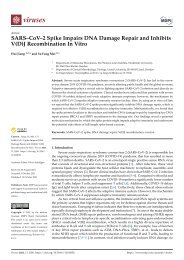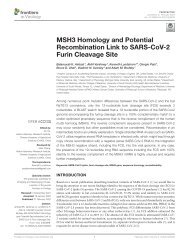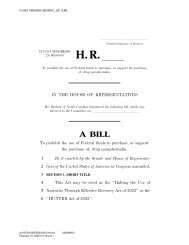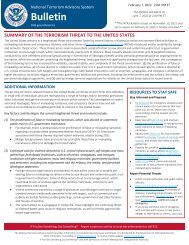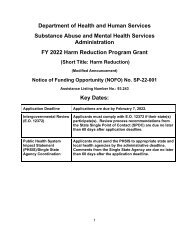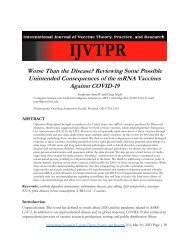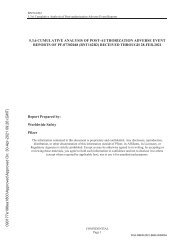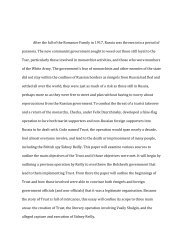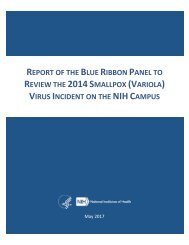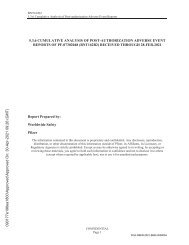A Literature Review and Meta Analysis of the Effects of Lockdowns on COVID 19 Mortality
Create successful ePaper yourself
Turn your PDF publications into a flip-book with our unique Google optimized e-Paper software.
mitigating <strong>COVID</strong>-<strong>19</strong> spread”. But, 9 <str<strong>on</strong>g>of</str<strong>on</strong>g> <str<strong>on</strong>g>the</str<strong>on</strong>g> 43 (21%) results <str<strong>on</strong>g>the</str<strong>on</strong>g>y review find “no or uncertain<br />
associati<strong>on</strong>” between lockdowns <str<strong>on</strong>g>and</str<strong>on</strong>g> <str<strong>on</strong>g>the</str<strong>on</strong>g> spread <str<strong>on</strong>g>of</str<strong>on</strong>g> <strong>COVID</strong>-<strong>19</strong>, suggesting that evidence from<br />
that own study c<strong>on</strong>tradicts <str<strong>on</strong>g>the</str<strong>on</strong>g>ir c<strong>on</strong>clusi<strong>on</strong>.<br />
The findings c<strong>on</strong>tained in Johanna et al. (2020) are in c<strong>on</strong>trast to our own. They c<strong>on</strong>clude that<br />
“for lockdown, ten studies c<strong>on</strong>sistently showed that it successfully reduced <str<strong>on</strong>g>the</str<strong>on</strong>g> incidence,<br />
<strong>on</strong>ward transmissi<strong>on</strong>, <str<strong>on</strong>g>and</str<strong>on</strong>g> mortality rate <str<strong>on</strong>g>of</str<strong>on</strong>g> <strong>COVID</strong>-<strong>19</strong>.” The driver <str<strong>on</strong>g>of</str<strong>on</strong>g> <str<strong>on</strong>g>the</str<strong>on</strong>g> difference is threefold.<br />
First, Johanna et al. include modelling studies (10 out <str<strong>on</strong>g>of</str<strong>on</strong>g> a total <str<strong>on</strong>g>of</str<strong>on</strong>g> 14 studies), which we<br />
have explicitly excluded. Sec<strong>on</strong>d, <str<strong>on</strong>g>the</str<strong>on</strong>g>y included interrupted time series studies (3 <str<strong>on</strong>g>of</str<strong>on</strong>g> 14 studies),<br />
which we also exclude. Third, <str<strong>on</strong>g>the</str<strong>on</strong>g> <strong>on</strong>ly study using a difference-in-difference approach (as we<br />
have d<strong>on</strong>e) is based <strong>on</strong> data collected before May 1 st , 2020. We should menti<strong>on</strong> that our results<br />
indicate that early studies find relatively larger effects compared to later studies.<br />
Our main c<strong>on</strong>clusi<strong>on</strong> invites a discussi<strong>on</strong> <str<strong>on</strong>g>of</str<strong>on</strong>g> some issues. Our review does not point out why<br />
lockdowns did not have <str<strong>on</strong>g>the</str<strong>on</strong>g> effect promised by <str<strong>on</strong>g>the</str<strong>on</strong>g> epidemiological models <str<strong>on</strong>g>of</str<strong>on</strong>g> Imperial College<br />
L<strong>on</strong>d<strong>on</strong> (Fergus<strong>on</strong> et al. (2020). We propose four factors that might explain <str<strong>on</strong>g>the</str<strong>on</strong>g> difference<br />
between our c<strong>on</strong>clusi<strong>on</strong> <str<strong>on</strong>g>and</str<strong>on</strong>g> <str<strong>on</strong>g>the</str<strong>on</strong>g> view embraced by some epidemiologists.<br />
First, people resp<strong>on</strong>d to dangers outside <str<strong>on</strong>g>the</str<strong>on</strong>g>ir door. When a p<str<strong>on</strong>g>and</str<strong>on</strong>g>emic rages, people believe in<br />
social distancing regardless <str<strong>on</strong>g>of</str<strong>on</strong>g> what <str<strong>on</strong>g>the</str<strong>on</strong>g> government m<str<strong>on</strong>g>and</str<strong>on</strong>g>ates. So, we believe that Allen (2021)<br />
is right, when he c<strong>on</strong>cludes, “The ineffectiveness [<str<strong>on</strong>g>of</str<strong>on</strong>g> lockdowns] stemmed from individual<br />
changes in behavior: ei<str<strong>on</strong>g>the</str<strong>on</strong>g>r n<strong>on</strong>-compliance or behavior that mimicked lockdowns.” In ec<strong>on</strong>omic<br />
terms, you can say that <str<strong>on</strong>g>the</str<strong>on</strong>g> dem<str<strong>on</strong>g>and</str<strong>on</strong>g> for costly disease preventi<strong>on</strong> efforts like social distancing<br />
<str<strong>on</strong>g>and</str<strong>on</strong>g> increased focus <strong>on</strong> hygiene is high when infecti<strong>on</strong> rates are high. C<strong>on</strong>trary, when infecti<strong>on</strong><br />
rates are low, <str<strong>on</strong>g>the</str<strong>on</strong>g> dem<str<strong>on</strong>g>and</str<strong>on</strong>g> is low <str<strong>on</strong>g>and</str<strong>on</strong>g> it may even be morally <str<strong>on</strong>g>and</str<strong>on</strong>g> ec<strong>on</strong>omically rati<strong>on</strong>al not to<br />
comply with m<str<strong>on</strong>g>and</str<strong>on</strong>g>ates like SIPOs, which are difficult to enforce. Herby (2021) reviews studies<br />
which distinguish between m<str<strong>on</strong>g>and</str<strong>on</strong>g>atory <str<strong>on</strong>g>and</str<strong>on</strong>g> voluntary behavioral changes. He finds that – <strong>on</strong><br />
average – voluntary behavioral changes are 10 times as important as m<str<strong>on</strong>g>and</str<strong>on</strong>g>atory behavioral<br />
changes in combating <strong>COVID</strong>-<strong>19</strong>. If people voluntarily adjust <str<strong>on</strong>g>the</str<strong>on</strong>g>ir behavior to <str<strong>on</strong>g>the</str<strong>on</strong>g> risk <str<strong>on</strong>g>of</str<strong>on</strong>g> <str<strong>on</strong>g>the</str<strong>on</strong>g><br />
p<str<strong>on</strong>g>and</str<strong>on</strong>g>emic, closing down n<strong>on</strong>-essential businesses may simply reallocate c<strong>on</strong>sumer visits away<br />
from “n<strong>on</strong>essential” to “essential” businesses, as shown by Goolsbee <str<strong>on</strong>g>and</str<strong>on</strong>g> Syvers<strong>on</strong> (2021), with<br />
limited impact <strong>on</strong> <str<strong>on</strong>g>the</str<strong>on</strong>g> total number <str<strong>on</strong>g>of</str<strong>on</strong>g> c<strong>on</strong>tacts. 47 This may also explain why epidemiological<br />
model simulati<strong>on</strong>s such as Fergus<strong>on</strong> et al. (2020) – which do not model behavior endogenously –<br />
fail to forecast <str<strong>on</strong>g>the</str<strong>on</strong>g> effect <str<strong>on</strong>g>of</str<strong>on</strong>g> lockdowns.<br />
Sec<strong>on</strong>d, m<str<strong>on</strong>g>and</str<strong>on</strong>g>ates <strong>on</strong>ly regulate a fracti<strong>on</strong> <str<strong>on</strong>g>of</str<strong>on</strong>g> our potential c<strong>on</strong>tagious c<strong>on</strong>tacts <str<strong>on</strong>g>and</str<strong>on</strong>g> can hardly<br />
regulate nor enforce h<str<strong>on</strong>g>and</str<strong>on</strong>g>washing, coughing etiquette, distancing in supermarkets, etc. Countries<br />
like Denmark, Finl<str<strong>on</strong>g>and</str<strong>on</strong>g>, <str<strong>on</strong>g>and</str<strong>on</strong>g> Norway that realized success in keeping <strong>COVID</strong>-<strong>19</strong> mortality rates<br />
relatively low allowed people to go to work, use public transport, <str<strong>on</strong>g>and</str<strong>on</strong>g> meet privately at home<br />
during <str<strong>on</strong>g>the</str<strong>on</strong>g> first lockdown. In <str<strong>on</strong>g>the</str<strong>on</strong>g>se countries, <str<strong>on</strong>g>the</str<strong>on</strong>g>re were ample opportunities to legally meet with<br />
o<str<strong>on</strong>g>the</str<strong>on</strong>g>rs.<br />
47<br />
In ec<strong>on</strong>omic terms, lockdowns are substitutes for – not complements to – voluntary behavioral changes.<br />
41




